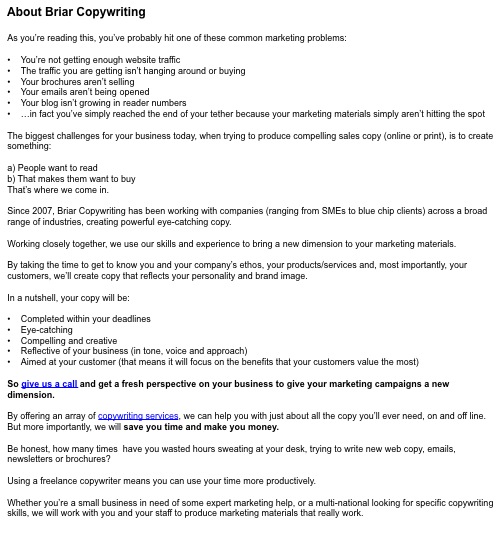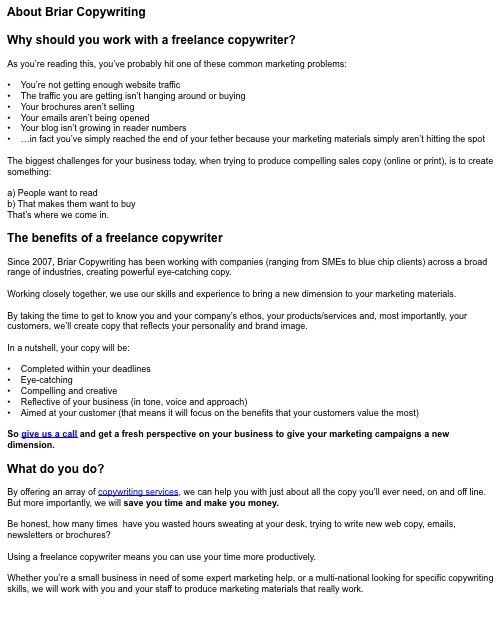Entries Tagged 'copywriter' ↓
March 11th, 2013 — copywriter, copywriting tips, Writer
A good piece of writing is one of those things that’s hard to define, but you know it when you see it. 
Words that flow, sentences that are easy to follow, paragraphs that draw you in all help to create text that appears effortless to the reader. So how can you make your writing better?
Well, there’s always the good old-fashioned way of reading lots and lots of great writing and hoping some of it will rub off on you. Or you can keep reading and discover 10 tips that are easy to do and that will have a dramatic effect on your writing.
If you’re ready, let’s get started.
1. Same old, same old
Clichés, hackneyed phrases, commonplace words, whatever you want to call them, should be avoided at all costs (doh!).
If you want to stand out as a writer, take the time to think of a different way of expressing yourself rather than falling back on trite phrases such as ‘in this day and age’ etc.
2. Converse
Not a new subject to this blog, but one worth repeating over and over, the most effective way of writing is a conversational style. It’s how we’re used to communicating with each other.
It’s friendly, unpretentious and it gets to the point quickly.
Keep your language simple, your sentences simple and your message simple.
3. You
For some people, writing in the second person seems quite strange, but it’s the best way to engage with your readers.
You see it more commonly on blogs where the author is writing directly to his or her readers and recounting personal experiences, so the use of ‘you’ and ‘I’ is fairly wide spread.
So what’s stopping you from using them in your sales writing? You’re still writing to a person, you still want to engage with them, so you should be addressing them directly.
4. Stories
Everyone loves a good story – since childhood they’ve been part of our lives, so don’t stop using them now.
Just to clarify, that doesn’t mean start your brochures with ‘Once upon a time…’, that would just be daft. The story should be a case study or testimonial that shows how your product or service has helped a real person in real life.
5. Watch your grammar and spelling
An obvious one, but it still needs to be talked about.
Always check and double check your writing before publishing it. No one is expecting you to be a red-hot grammarian, but at least try and get the basics right.
The same goes for your spelling. Although your trusty spell checker will throw up blaring errors, it may not spot those occasions when you’ve used the wrong their or there. So always make sure you check your writing, or get someone else to, before publishing.
6. No flower power
Flower power?
That is what will happen to your writing if you over do the adjectives.
Adjectives are the ‘descriptive’ words that turn your writing into horrible flowery prose.
After writing your first draft, read through and cut out as many of the little suckers as you can. The end result will be leaner and far more powerful.
7. Adverbs
Yuk – a bit like the adjective, and adverb can kill your writing so chose your words carefully.
Why use a phrase like ‘ran quickly’ when ‘dashed’ has more effect?
8. !
Yes, I know I used one earlier, but surely I can be forgiven just one, can’t I?
Exclamations are great in reported speech and dialogue, but it’s unlikely you’ll be using either in your sales writing.
The words you use should be able to convey stresses without having to stick a ! at the end of them.
9. Cut
As you write you will have the tendency to add in all sorts of words that aren’t needed. Once you’ve completed your first draft, read through and cut out any words that don’t add meaning.
Tightening your message this way will increase its impact.
10. Evidence
If you write about something without offering examples or backing up your arguments with evidence, your writing is going to come across as being hollow.
Make sure you add in statistics, quotes and other research data to support your points.
There you go, I’m sure there are many other tips to help you write like a pro, but these 10 are my favourites.
If you have any other tips leave a comment below and let’s see how many we can come up with.
Author: Sally Ormond, MD and copywriter at Briar Copywriting Ltd

March 1st, 2013 — copywriter, copywriting, copywriting tips, marketing, online marketing, website copywriter, website copywriting, website design
Clarity – copywriting – images – scanable text – clear navigation – easy on the eye 
These are just a few things a successful website needs. Although the title of this blog post is ‘Engaging through web design’ it will delve deeper to look at the elements of a successful website, including web copy, layout and colour.
Let’s start at the beginning.
Plain English
When someone lands on your website (assuming they are English) their eyes will automatically be drawn to the top left and scan in a left to right motion, from top to bottom.
The first thing they’ll want to know is that they’ve arrived at the right place. That’s why your company name and strapline must be at the top of your website. After that there should be some well written words highlighting what you can do for them – yes, afraid so, this isn’t the place for a long essay on how great your company is.
It’s essential your opening gambit is powerful as this will determine whether the visitor will remain on your site to find out more, or navigate away to find another website.
But powerful doesn’t mean ridiculously complex words and sentences in an attempt to show your intelligence – it won’t.
What it will do is show you as a company that is far more interested in its own importance than it is it’s customers. That’s why you should always use plain and simple English to get your point across succinctly.
Clear navigation
The ability to easily navigate around your website is vital to enhance the user experience.
For example every website needs an “About Us” page so the user can learn a bit about the company they may be about to do business with. The name “About Us” fits this purpose perfectly. So why then do you find websites that use other, more obscure names for this page?
If you have a page that talks about your services, call it the “Services” page – it’s not rocket science.
By keeping your page names simple and obvious your visitors will be able to find their way around your website with ease – don’t make them hunt for information.
The other aspect of your navigation is to keep it to a minimum. There’s nothing more frustrating than landing on a website that’s full of hyperlinks – how will your visitor know where to click? Make sure your navigation is clear and simple to make moving around your website as intuitive as possible.
Readability
Earlier we mentioned the importance of using plain, simple English on your website, but you also need to make sure that it’s laid out in such a way that reading it is effortless.
The best way to achieve this is by including plenty of white space on your page. Taking this post as an example, you can see that I’ve used lots of short paragraphs and sub headings to help you, the reader, find the information you need.
The white space breaks up the text making it appear easier to digest. But it’s not just layout that you need to consider, colour also comes into play.
Have you noticed the number of websites these days that are using grey text on a white background? Yes, they look very modern, but for some readers this can pose problems because of the lack of contrast. Try and stick to high contrasts, like black on white, to make it easier for people of all ages to read what you have to say.
Prioritise your information
As with everything in life the most important stuff should come first.
When laying out your text, prioritise the order in which it will appear with the main benefits first leading on to the features and finally any other supporting information you have.
This will make sure the reader is hit with the important facts (the benefits) first, which will ultimately help them make their buying decision.
If you leave these until the end, you run the risk of losing them before they reach them.
As you can see, an effective website is a lot more than just an eye-catching design. Every aspect of your site, from its content to it’s images, layout and navigation, will have an impact on its success.
Take a few minutes out now to look at your website. Does it tick all the boxes, or is there room for improvement?
February 25th, 2013 — copywriter, copywriting, copywriting tips
Invisible writing? 
Let me explain.
The role of a copywriter is to write stonking copy that:
- Grabs the attention of the reader
- Persuades them that the product or service in question is what they’ve been looking for
- Convinces them to buy
- Compels them to get their wallet out and part with their hard earned cash
Plus, they have to do all that without being obvious about it.
Although copywriters write for a living, unlike the J K Rowlings, David Baldaccis and Scott Marianis of this world, their writing has to remain invisible – i.e. it shouldn’t be the reason for someone to stop and read.
Copywriters have a tough life – they are great at what they do and excellent writers, but they’ll never receive the recognition that our literary greats enjoy.
But the fact remains that the writing used to sell a product or service should do just that – sell. It shouldn’t be hailed for its literary merits, or be seen as the best-written piece since…well, the last best-written piece ever. It should just do its job without fanfare.
Writing with power
How do you achieve all of that?
The first stage is to picture your reader and write to them.
Yes, the actual audience you’re writing for will be more than just one in number and most probably quite varied, but by keeping one typical reader in mind you’ll be able to focus your writing on them and their needs.
The next stage is to develop an informal, conversational style of writing (in the second person). Write as though you’re having a chat with the reader over a coffee.
As you start to write always keep in mind the structure of a story. We’ve all grown up listening to them and so are predisposed to taking them in and believing them.
Once you have done your research into the company, product/service and audience you’re writing for, focus on the key benefits and shout about them. They are the lynchpin of your copy – they are the things that will convince the reader to buy what you’re selling.
By keeping your language and sentence structure simple and jargon free, you’ll be able to get your message across clearly. And following it up with a powerful call to action, you’ll have the reader eating out of your hand and reaching for their wallet.
Keep the reader in focus
As a copywriter, everything you write is about someone else; it’s never about you.
If you have a compelling urge to write great prose, my advice would be to write a novel. Keep your flamboyance for that and keep your copy clean, simple and every so quiet.
January 21st, 2013 — Building a business, Content marketing, copywriter, copywriting tips, website copywriting
Promoting your business online needs a lot of content.
Your website copy, blogs or articles must be relevant, interesting and useful to your readers otherwise they will be no more that just a collection of words.
When you’re a sole trader it’s very easy to fall into the trap of writing about yourself.
Hang on a moment…
Oh, hi Joe (Joe’s a self employed plumber), how’s it going?
What? Yeah, fine. What do you mean trap? Of course I’m gonna write about myself, I am my business and people want to know about me.
Are you sure about that Joe?
Are you taking the p…
Hang on, there’s no need to be like that. Look at it from your customer’s prospective for a moment.
Yeah, they want to know about me, who I am and what I do, obviously.
No, they don’t. They want to know what you can do for them.
Same thing.
No it’s not. Look, the fact that you’ve been in business for 10 years, you drive a blue van and your favourite pizza topping is ham and pineapple is of no interest to your customers. They want to know how quickly you can get to them, and the type of work that you do.
Really?
Yes, really. If they’re searching online for a plumber it’s generally because they have a leak, need a new bathroom installing or something else along those lines. In other words, they have a problem to which they need to find a solution – you. That’s why your web copy, articles and blogs all have to be focused on what you can do for them.
OK, you may have a point.
There’s no maybe about it Joe. If you want your content to be read and you want people to come to your site and think ‘hey, Joe’s the guy for me, he offers the service I need and can come out to me quickly’ then you have to write it for them. If you just fill it with loads of information about you and only you, you’re not giving them what they want.
Joe…hey Joe, where’ve gone?
Just looking at my web copy again…don’t suppose you want to write it for me?
Writing for your readers
Separating yourself from you business and writing about it as though you were a customer is difficult.
You have to place yourself in the shoes of your readers and think about what’s important to them.
These are the basis of the benefits of your product or service – the things that add value to your customers. Keeping them at the heart of everything you write will keep you on track.
One final word – to make sure you don’t deviate, make sure you use ‘you’ instead of ‘we’ on your website, even on your About Us page.
Here are 3 takeways to remember when writing your content:
- Always write for your reader not yourself
- Use a lot of ‘you’
- Write conversationally to boost engagement
December 17th, 2012 — Content writer, copywriter, copywriting, copywriting tips
Content rules the Internet and considering most of that is in the form of words, that’s a lot of reading.
You all know that reading from a screen is more difficult than reading from books or magazines. That’s not to say that your intellect suddenly falls several points when faced with a computer screen, but rather reading from a back-lit screen can be rather tiring on your eyes, which leads to less concentration.
That’s why its important to use sub headings – a feature used by every professional copywriter you’ll come across – because they make it easier for readers to read.
The best way to show you the effect sub headings have is through an actual illustration. Below is a sample of copy taken from by About Us page – first of all without any sub headings:

As you can see, even with the paragraphs intact the piece doesn’t really make you want to read. The text looks too dense and there is no direction as to what information the page contains.
Now let’s look at it again with the sub headings in place:

This time there is much more structure to the page. The sub headings act as signposts telling the reader what information the page contains making it easier for them to navigate to the section they want to read.
The aesthetics of sub headings
Aesthetically, the page looks more inviting with sub headings: a solid wall of text gives the impression that the subject matter is going to be difficult to read and boring, so it won’t encourage people to give up their valuable time to read it.
With sub headings the reader can break the page down:
- The sub headings act as rest points; the reader can break of at any time and not lose their place.
- They can glance down the page and pick out the information they need
- They give the impression of an ‘easy read’, which subconsciously suggests the information will be easy to grasp
So you see, just the simple inclusion of sub headings in your writing can boosts its readability.
Next time you’re writing website copy, brochures, blogs or articles, pay special attention to how you lay the information out. Use sub headings and short paragraphs to make it easy to follow and understand, that way you’ll boost your engagement with your readers.












